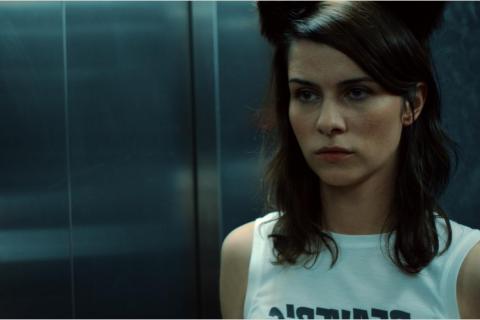Everyone’s Going to Die (Jones)
 Everyone’s Going To Die is a lesson in momentum. After a rough and tonally awkward beginning, it hits its stride and never looks back. Shades of Lost in Translation pervade the film and we can accept this journey between an older man named Ray (Rob Knighton) with a history and a young woman named Melanie (Nora Tschirner) just trying to discover herself. Set in the UK, the film begins with a chance enounter that grows into a friendship and then eventually, into something much more. However, the physicality isn’t what is important, it’s the emotional attachment and how they balance each other.
Everyone’s Going To Die is a lesson in momentum. After a rough and tonally awkward beginning, it hits its stride and never looks back. Shades of Lost in Translation pervade the film and we can accept this journey between an older man named Ray (Rob Knighton) with a history and a young woman named Melanie (Nora Tschirner) just trying to discover herself. Set in the UK, the film begins with a chance enounter that grows into a friendship and then eventually, into something much more. However, the physicality isn’t what is important, it’s the emotional attachment and how they balance each other.
Beautifully shot and edited, the film’s style stands out as coming from someone who has a distinct vision and nails it, but it’s an intriguing concept when we learn this project is directed by a collective simply known as Jones. There is one sequence where Melanie is talking in a continuous take for over three minutes. She rifles off answer after answer, and it’s a beautiful sequence that showcases the talent in front of and behind the camera.
There’s always a fear in adolescence that we won’t find our passion or desire and simply float through life. I find it important to follow dreams and make something happen, but Melanie is a floater. The same seems to be the case with Ray, and the two seem to strike each other’s matches to get out of their rut. There’s a sweetness to the entire film that is hard to peg, and like many coming-of-age films there is an uneasiness at times that helps one realize these aren’t perfect lives, but they are made better by each other. There are small issues in a grander context, but they are major issues in Ray and Melanie’s world. Put bluntly, Everyone’s Going To Die is a mostly charming, but flawed film that takes its time.
Grade: B-
Linsanity (Evan Jackson Leong)
 What can you add to a narrative that has been thoroughly explored in the 24/7 newscycle of sports? One cringes at the thought. We are talking about a story that took the world by story in a few short weeks and turned into a phenomenon. Yet, with places like ESPN, Fox Sports, Yahoo Sports, Sports Illustrated, and any number of illustrious sports news outlet covering the rise of NBA guard Jeremy Lin, you have to wonder how much more there is. Turns out, there isn’t an awful lot left.
What can you add to a narrative that has been thoroughly explored in the 24/7 newscycle of sports? One cringes at the thought. We are talking about a story that took the world by story in a few short weeks and turned into a phenomenon. Yet, with places like ESPN, Fox Sports, Yahoo Sports, Sports Illustrated, and any number of illustrious sports news outlet covering the rise of NBA guard Jeremy Lin, you have to wonder how much more there is. Turns out, there isn’t an awful lot left.
Linsanity begins by showing the successful realization of a dream by Jeremy Lin, and then steps back to showcase there rough and unlikely way he captured his dreams. I should note that while the film has a focus on Lin’s Christian beliefs, it does a grand job of avoiding placing the credit solely on his belief in a higher power. He mentions his faith and how much he feels it’s a factor, but one can also see the enormous amount of work and effort he put in behind the scenes.
We are treated to documentary footage of Lin in candid interviews from over two years before he was known around the globe. Why that footage exists is perplexing, but it does and provides a look at Lin’s mentality before and after. If one isn’t a sports fan, the film follows the Asian-American Lin on his journey to become a star point guard for the New York Knicks, through many unlikely circumstances and numerous struggles. He set records for his sudden burst of scoring ability, passing, defense, and hustle. However, he toilded in the D-league for many years, often being cut from team to team. But he was relentless, and it’s paid off. Unfortunately, the documentary never turns the corner from adequate to dramatic. We see endless cliches and learn very little of significant importance. The lesson seems to be mainly luck. Or, in Lin’s case, God’s plan for him.
His Asian heritage is touched on (again, something that was done in the news cycle) and we see how his ladder to the NBA was seemingly cut out from under him because there simply aren’t many successful Asian players in the NBA, let alone a point guard. In fact, outside of the Yao Ming experiment in Houston and a handful of other abnormally tall Asian players — both culturally and in the NBA — Lin seems to be the lone one in a starting lineup below 6’9″. If you’re very familiar with Lin’s story, there isn’t much interesting here. For those completely unaware of Lin’s story, it may be a worthwhile, but standard encapsulation of the news you missed.
Grade: C
The Blue Umbrella (Saschka Unseld)

The Pixar short films have been nothing but spectacular. For a long time, they matured in greatness, alongside their feature film library. However, in contrast with the downturn of Pixar’s features of late, their shorts have remained consistently different, superb and lasting. Their latest, The Blue Umbrella, is no different, as one will find themselves soaking up all of the wonderful imagery in the six minute film. There is a new vibe brought to the table here, one of hyper-realism and seemingly like it might actually be airbrushed live-action. Everything is a bit too flawless, but the realism of the visuals is only part of the story.
Reviewing a short is odd, because nearly any detail could be considered a spoiler, so let’s get this out there: The Blue Umbrella is about an umbrella in the sea of dreary portable rain shelters that actually loves the rain. We see how objects around the umbrella interact with the rain. Gutters have faces, with eyes for screws and the spouts for mouths, and they seem to enjoy their job of funnelling the luxuriously detailed rain water. We learn that the surroundings notice the umbrellas as well, and the world comes alive in the rain. Without spoiling what occurs, The Blue Umbrella carries on the stellar legacy of the Pixar shorts, with its charming heart and inventive style.
Grade: A
Note: The Blue Umbrella will show before Monsters University this June, so check back for my interview with the producer and director of this short around that time.

